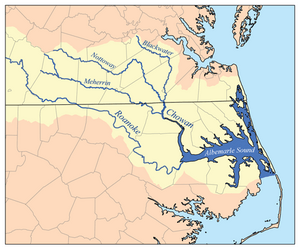Weapemeoc Indians facts for kids

Weapemeoc lived on the north shore of Albemarle Sound
|
|
| Total population | |
|---|---|
| extinct | |
| Regions with significant populations | |
| United States, North Carolina | |
| Languages | |
| Carolina Algonquian language |
The Weapemeoc Indians were a Native American tribe. They lived in northeastern North Carolina. Their home was on the north shore of Albemarle Sound. People first wrote about them around 1585. At that time, about 700 to 800 Weapemeoc people lived there. They had a culture based on the water. But their way of life changed fast. European settlers brought new diseases. The Weapemeoc were eventually forced from their lands by 1780.
Contents
What Does "Weapemeoc" Mean?
The name Weapemeoc has a special meaning. It can mean "where shelter from the wind is sought." Some experts think it means "People of the First Light." This is like "People of the Dawn Land." Other tribes, like the Wabanaki or Wampanoag, have similar names.
The tribe was also called Yeopim. This was a shorter name. It might have come from settlers trying to say the tribe's original name. The Weapemeoc tribe also had smaller groups. Each of these groups had their own names.
Weapemeoc History Before Colonization
Early Records and Movements
The Weapemeoc Indians were first written about in 1585. Around this time, they had about 700 to 800 people. They moved around different counties in North Carolina. These included Currituck, Pasquotank, Perquimans, and Chowan.
Even though they were first noted in 1585, historians know more about their past. This is because Weapemeoc people shared their stories. Around 1550, the Weapemeoc tribes were peaceful. They often formed alliances with nearby tribes.
Conflicts and Changes
From 1585 to 1586, a map was made. It showed the Weapemeoc land along the coast and rivers. In 1607, the James River area became a battleground. The Weapemeoc Nation fought there. They also fought the Powhatan Confederacy and other tribes.
Battles continued in 1622. These were between tribes and English settlers. This time became known as the Indian Massacre of 1622. A few years later, in 1625, many Native Americans died. There was an outbreak of smallpox and measles. Native people did not have natural protection from these diseases.
European Arrival and Impact
By 1650, more Europeans came to North Carolina. Many settlers arrived in the Albemarle region. There were about eight men for every one woman. Around 1670, British men started marrying local Native American women. This helped different cultures mix. It also led to talks to end the fighting.
However, battles still went on during these talks. As a result, the tribe's population dropped a lot. By 1700, there were only about 200 Weapemeoc people left. European settlers completely surrounded the tribe. Peace did not last. Many tribal members moved to Indiantown.
Weapemeoc Life During Colonization
The Weapemeoc Indians lived in what is now northeastern North Carolina. In the early 1580s, their culture changed greatly. This happened when European colonizers arrived. The English set up a settlement from 1584 to 1586. Later, Spanish, Portuguese, and French explorers also made settlements.
At first, the Weapemeoc and settlers met only on the shoreline. But these meetings soon led to conflict. Europeans tried to move the tribe from their traditional water-based way of life. Some Weapemeoc groups made friends with the settlers. Others stayed true to their old ways. Those who met settlers often exchanged cultural traditions.
By the early 1700s, two other Algonquian-speaking tribes moved into Weapemeoc lands. These were the Poteskeets and the Yeopim. The English created a reservation for the Yeopim in 1704. But this land was sold in 1739. By the mid-1700s, the Weapemeoc tribe had mostly disappeared in North Carolina.
Weapemeoc Culture and Daily Life
Language and Skills
The Weapemeoc Indians spoke an Algonquian language. They were very skilled. They were good hunters, farmers, and fishermen. They lived near banks and rivers. This meant they had fresh fish, clams, and mussels all year.
They used many tools for fishing. These included spears, hooks, and nets. Their food also included seasonal crops like corn. They hunted animals with bows and arrows.
Beliefs and Traditions
Water was very important in their daily lives. Many of their religious rituals and beliefs were about water. For example, if the water was rough, or a storm seemed to be coming, they would act. The Weapemeoc Indians would throw tobacco and other herbs into the water. They hoped this would make things better. However, this water-based culture slowly faded. This happened as Europeans moved into their lands.

